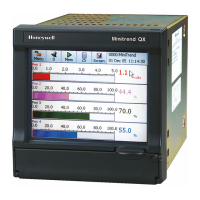56 43-TV-25-30 Iss.6 GLO Aug 07 UK
• Label - Select and enter a identification label for the input. Select and enter a label. Max
15 characters.
• SQRT Extract - (Ohms, Volts and Amps only). Toggle On and Off. The Square root
extraction in the analogue input is used to linearise certain sensors that have a non lin-
ear output - for example in the calculation of flow. So when you check the Square root
extraction in the Analogue input section it carries out the following calculation. It ratios
the analogue input range that you set, to 0 to 1. So any sensor input is represented by a
number from 0 to 1. We then take the square root. We then re ratio the result back to
the user set range.
• Sensor Comp - Sensor Compensation may be required to improve accuracy on a sub
range. This is an adjustment to the value of the signal input on each channel, based on
the Engineering units settings. See
“Sensor Compensation” on page 299
• High Limit - Available when Range is User Defined. Select and enter the high limit
value.
• Lower Limit - Available when Range is User Defined. Select and enter the lower limit
value.
• RT Type - Only available when Type is set to RT (Resistance Thermometer). Select this
for a list of available RT types.
• Burnout Type - Only available when Type is set to TC (Thermocouple). Toggle
between Active and Passive. Active means it will send out a current to the TC. Set to
Passive means it takes a reading without sending out a current. The T/C is wired differ-
ently for Active and Passive Burnout (see
Figure 2.7, “Input signal wiring,” on
page 19
). (Active Burnout is not available for the eZtrend QXe recorder).
Active Burnout checks the health of the thermocouples every 30 seconds, if your proc-
ess requires continuous check of the thermocouples to see if they are in burnout you
should use Passive Burnout. Active burnout is an implementation of thermocouple
health and provides error warning messages for a range of thermocouple activity/failure
conditions. Passive burnout does not provide any error warning messages.
If the thermocouple wiring changes and the channel is set to Active, select Passive and
Commit the change. Then return to the menu and select Active and Commit the change
to update burnout settings.
• Show Burnout - Only available when Type is set to TC. Toggle between Upscale and
Downscale Burnout.
• TC Type - Only available when Type is set to TC. Select this for a list of available TC
types.
• CJ Comp - Only available when Type is set to TC. Select this for a list of available CJ
Compensation. See
“Thermocouple CJC Compensation” on page 286.
• • Int Automatic - Uses the cold junction sensor in the recorder as a variable ref-
erence temperature
• • Ext 0 Deg C - Assumes the cold junction is held at 0
C to provide a 0mV refer-
ence, external to the recorder
• • Ext with Spec Temp - Uses a reference junction held at a constant tempera-
ture. Specify the temperature that the cold junction sensor is to be set at.
• • Ext Input - Use a thermocouple or resistance thermometer from another chan-
nel to measure the cold junction sensor
• External Input - Only available when CJ Compensation is set to Ext Input. Select the
input required as an external input.

